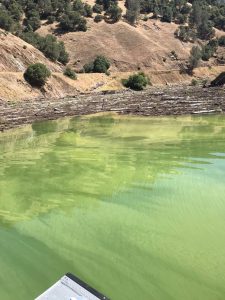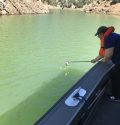Sonora, CA — A concerning algal bloom above New Melones and the reservoir’s distinctly green tint triggered a joint inspection by state and local officials.
Tuolumne County Board Chair Karl Rodefer and Calaveras County District 4 Supervisor Dennis Mills were among the Mother Lode representatives who donned lifejackets Thursday for a boat tour with environmental health staff from both counties and staff from Water Board and Bureau of Reclamation.
Earlier this week as reported here, test results came in providing the current status of a potential harmful algal bloom (HAB) of cyanobacteria in the Middle Fork of the Stanislaus River upstream of the New Melones reservoir. The three water samples taken found the presence of the cyanobacteria Dolichospermum dominant in the bloom. Cyanobacteria Aphanizomenon was also noted by Water Board staff in two shoreline collection samples subdominant in the bloom. Although the results did not detect toxins in the blooms, a caution advisory is still being recommended until the bloom subsides. Caution signs (click into the image box slideshow to view the full list of recommended cautions posted) are in place from the Tuttletown boat ramp all along the river to Camp Nine and the log jam.
Rodefer, sharing post-tour laymen’s observations with Clarke Broadcasting, noted that the bloom is currently most active at the log-jam. More samples were taken, including by the Tuttletown Rec Area boat launch off of Reynolds Ferry Road. He gave kudos to the Calaveras and Tuolumne environmental health offices for staying on top of the situation and extended thanks for the continuing support of Water Board staff.
As for monitoring protocol moving forward, “Basically, Melones staff is going to continue to monitor and provide samples,” he explained. “From my understanding, [the algal presence in the lake below the log-jam] is mostly discoloration. It is very green up by the log-jam and less so as you come back towards the dam.” He confided he would personally avoid skin contact in the greener waters as well as the posted caution areas. He added, “Be careful but please use the lakes — it’s that time of year.”
Possible Reasons For The Bloom
Following Thursday’s joint tour, Tuolumne County Environmental Health Director Rob Kostlivy shared that besides assessing the algal spread or growth, environmental health officials and scientists looked at the local ecology to try to ascertain why there is a growth this summer.
“The cyanobacteria prefers warm still waters in contrast to fast-moving waters/currents typically found in rivers. This is why the ecology conversation was so vital,” Kostlivy stated. Among the hypotheses is that the Donnell Fire last August may have caused organic material and nutrients to wash into the watershed and flow downstream. “Also, we received several late-season Pineapple Express storms, which contributed to runoff and also…to warmer waters.”
He added that the upstream log-jam really slows the river flow and that it may be creating a layered water layer with the warmer water slowing at the surface as cooler water is being channeled below it. He reports that the water temperatures were above 80 degrees Fahrenheit, which is considerably warmer than other areas of the river and lake.
“With that said, we would like to remind our constituents that we still have an advisory in effect for the areas from the Parrotts Ferry Bridge on up to the Camp 9 [bridge] and to the log-jam,” Kostlivy continued.
He further shared that the team felt the joint inspection was successful and well worth the effort. “Both Calaveras and Tuolumne board of supervisor members were able to get a firsthand view of the bloom so that they could address questions from their respective counties and have an understanding of how the testing process and timelines play out.”




